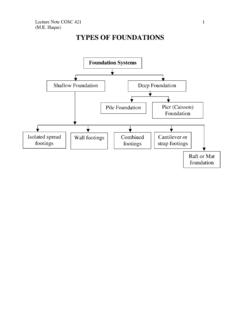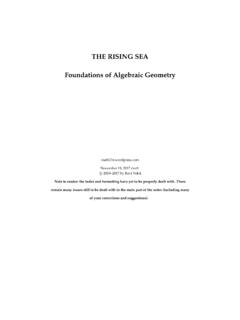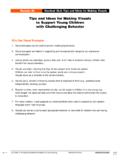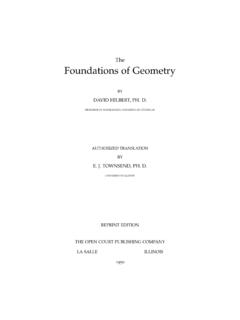Transcription of Historical foundations of education Presentation Transcript
1 Historical DEVELOPMENT OF education Presentation Transcript Page # 1 1 1. Historical foundations OF education 7000 BC 5000 BC Pre-literate societies (before writing) Educational Goals: To teach survival skills, teach group harmony Students: Children Instructional Methods: Informal, children imitate adults Curriculum: Practice hunting, fishing, songs, poems, dances. Agents: Parents, tribal elders, religious leaders Influence on education : Informal, transmission of skills Schools probably existed in China almost 4000 years ago. As a highly developed society, the Chinese designed their schools around the perpetuation of tradition, compliance and conventionality, to allow their youth to function in an increasingly formal and complex society. The individual was not deemed particularly important, rather it was the individual's acceptance of the cultural traditions and practices and his place in society that characterized educational practice.
2 Females for the most part were not deemed worthy of a formal education . As with many other cultures, the Japanese system of education evolved after they developed a written language. Adapting the Chinese form of writing, the Japanese aristocracy was the first to learn to read and write. Originally the Japanese borrowed heavily from the Chinese culture in providing a curriculum of study. However, eventually the needs of Japanese society became paramount and the educational system began to reflect a Japanese culture and belief system. education was also used to provide for the societal needs such as the specific schools that were set up to train young men for civil service. CHINA 3000 BC 1900 AD China Educational Goals: Prepare elites to govern the empire according to Confucian principles Students: Males of upper class Instructional Methods: Memorization and recitation Curriculum: Confucian classics Agents: Government officials Influence on education : Written examinations for civil service The Hebrews valued education and centered their instruction around the teachings of their bible.
3 Harsh discipline also characterized educational practice along with a strict emphasis on following the laws of the Old Testament. Females were not formally educated, but instead were required to learn the skills associated with homemaking. Teachers were treated with great respect, indicative of the value that Hebrew society placed on education . Ancient Hindu societies were based on a strict adherence to a proscribed system of familial status known as the caste system, whereby an individual's status is determined by his family's place in the society. Formal education helped perpetuate this system by only allowing access to boys from the highest or Brahmin caste. Priests were used as teachers resulting in a heavy emphasis on moral development, learning to write, and harsh discipline. INDIA 3000 BC TO PRESENT India Educational Goals: To learn behavior and rituals based on Vedas Students: Males of upper castes Instructional Methods: Memorizing and interpreting sacred texts Curriculum: Vedas and religious texts Agents: Brahmin priest scholars Influence on education : Cultural transmission and assimilation, spiritual detachment The Egyptians developed a very early, highly civilized society.
4 They had a form of writing known as hieroglyphics, and were divided into castes. The priests were the most highly educated segment of society and provided the instruction for the privileged males deemed worthy of learning. Historical DEVELOPMENT OF education Presentation Transcript Page # 2 2 EGYPT 3000 BC 300BC Egypt Educational Goals: To prepare priests according to scribe for the empire Students: Males of upper class Instructional Methods: Memorization and copying texts Curriculum: Religious or technical texts Agents: Priests and scribes Influence on education : Restriction on educational controls to priest elites Around 500 BC, the Greeks developed a society that was divided into city-states and was sufficiently complex to require a formal educational system. Two of the more prominent were Athens and Sparta. education in Sparta was primarily for the purpose of developing a strong military to both protect from and conquer neighboring states.
5 Both boys and girls were subjected to a rigorous survival test of exposure to the elements during infancy to determine if they had the necessary capabilities to become warriors or mothers of warriors. Boys were then given physical and moral training to designed to develop a strong military. Development of the intellect was not considered to be of particular usefulness. In Athens, the approach to education was designed to promote the development of both body and mind. Boys were formally educated from the age of eight to sixteen in various disciplines, which emphasized the principles of moderation and balance. From ages sixteen to twenty, the boys underwent military training. Girls were educated in the home. Ancient Greece contributed much to our way of looking at and thinking about the concept of education . In particular, the philosophers, Socrates (470-399 BC), Plato (427-347 BC), and Aristotle (384-322 BC) had a profound influence on modern educational practice.
6 All three believed that a person's most important purpose was to serve and improve humankind and that education was designed for this end. Socrates developed a method of teaching called the Socratic method, whereby the teacher asks a series of questions that lead the student to a conclusion. This method is still commonly used in modern educational practice. Socrates believed that knowledge was a virtue and that it was essential to understanding. At times he was critical of the government and eventually chose to end his life rather than end his teaching. Plato was a student of Socrates. He was the father of idealism and believed that the aim of education was to develop an individual's abilities to better serve society. He founded the Academy, the world's first university, and was one of the first people to advocate the formal education of both males and females. As the father of Realism, Aristotle, who was a pupil of Plato, believed that knowledge exists independently in the world as opposed to Plato's belief that ideas are the ultimate reality.
7 He was the father of the scientific method and taught logic as a formal discipline. His writings greatly influenced humankind (Parkay & Stanford, 1998). GREEK 1600 BC 300 BC Greece Educational Goals: To cultivate civic responsibility Students: Male children ages 7-20 Instructional Methods: Memorization and recitation in primary schools, lecture, discussion and dialog in higher schools Athens Sparta Curriculum reading, writing, arithmetic, drama, poetry, music. Sparta: Drill, military songs and tactics Agents private teachers, philosophers. Military teachers Influence on education well rounded, liberally educated person. Concept of military state. Historical DEVELOPMENT OF education Presentation Transcript Page # 3 3 The Romans conquered Greece in 146 BC and started to assimilate many of the concepts and educational philosophies from the Greeks into their own system. The Roman school system divided instruction into two levels, consisting of an elementary period or ludus from age seven to twelve, and a secondary school from age twelve to sixteen.
8 Females were actually allowed to attend the ludus and receive a formal education . However, few girls received an education past age twelve. Quintilian (35-95 AD) was one of the most noted and far-thinking of the Roman educators. His writings, which were discovered in the 14th century, became the basis for the humanistic movement in education (Johnson, et al., 1996). Quintillion believed that corporal punishment was not necessary, that school holidays were needed to refresh and encourage the student to further study, that instruction should reflect the development of the child and that children shouldn't be taught new material until they could master it. ROMAN 750 BC 450 AD Roman Educational Goals: Develop civic responsibility for the empire, administrative and military skills Students: Male children ages 7-20 Instructional Methods: Memorization and recitation includus; declamation, rhetorical schools Curriculum: reading, writing, arithmetic, law, philosophy Agents: Private schools and teachers, schools of rhetoric Influence on education : practical administrative skills, relate education to civic responsibility The Dark Ages, as the period between the Fall of Rome and the beginning of the Middle Ages is known, was a period of little progress in human learning, at least in the western world.
9 In other regions, this was not the case. Mohammed, the prophet of Islam (569-632), inspired a rich period of discovery and learning flourished in this climate. Of particular note was the development of Arabic numerals, which replaced the cumbersome Roman system. Later, the Moors conquered southern Spain and the Arab culture slowly began to influence Western learning. In Western Europe during the Dark Ages, it was politically chaotic, with the invasion of Rome by barbarians and the break-up of the Roman Empire. Whereas Rome had formed the nucleus of a stable system of government and continuity that extended over large portions of the Western world, now this world was broken into much smaller and constantly warring states. The Roman Catholic Church was able to provide some form of stability and meaning to people through their emphasis on gaining entrance to heaven and de-emphasizing the importance of life on earth.
10 Human learning regressed during this period as the Church sought to control the education of the common people, placing increasing importance on obedience and denouncing the study of philosophy as contradictory to its teaching. In turn only the clergy and some nobility were allowed to learn to read and write. For the masses, teaching was done by the clergy and was directed towards inducting people into the faith, relying on oral transmission of liturgy. The power of the Roman Catholic Church was maintained through the hope of salvation and eternal life. The Church was the intercessor between heaven and (742-814) of the Franks attempted to establish schools and promote education . Even though Alcuin (735-804), Charlemagne's advisor and teacher, aided him in this task, they were unable to make much progress. Around 1000 AD, humankind slowly began to realize the importance and need for learning.










